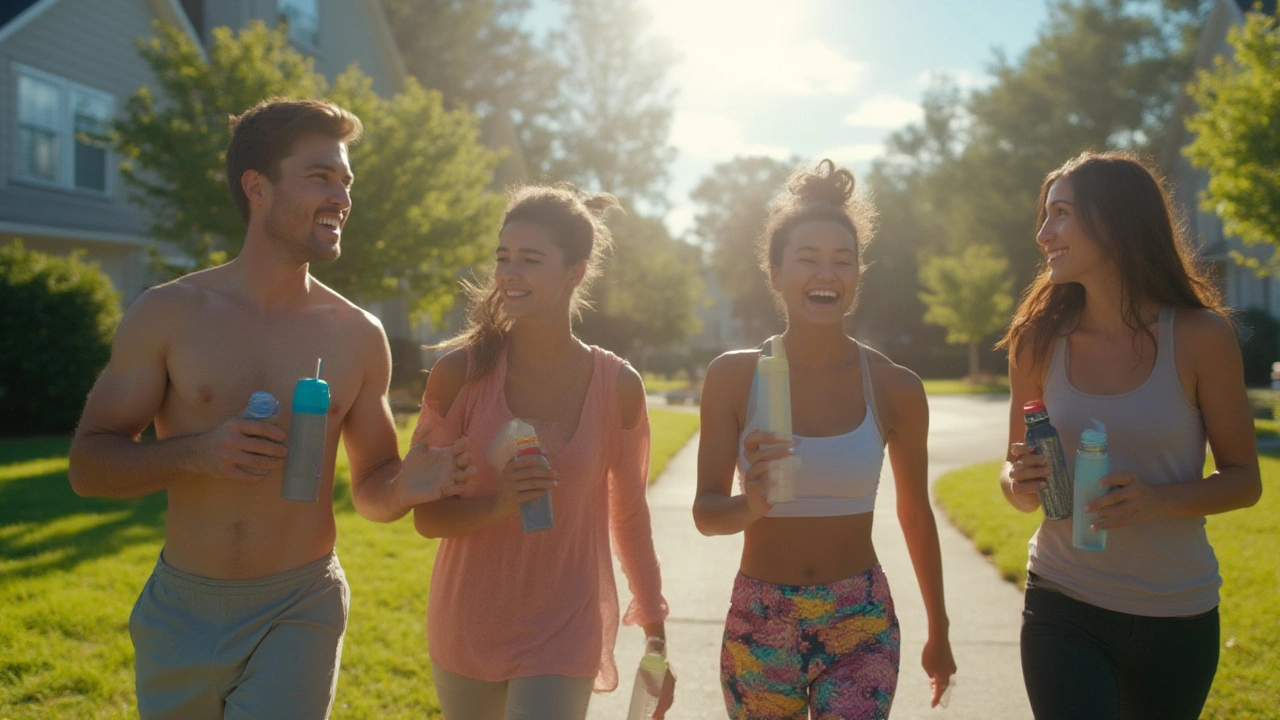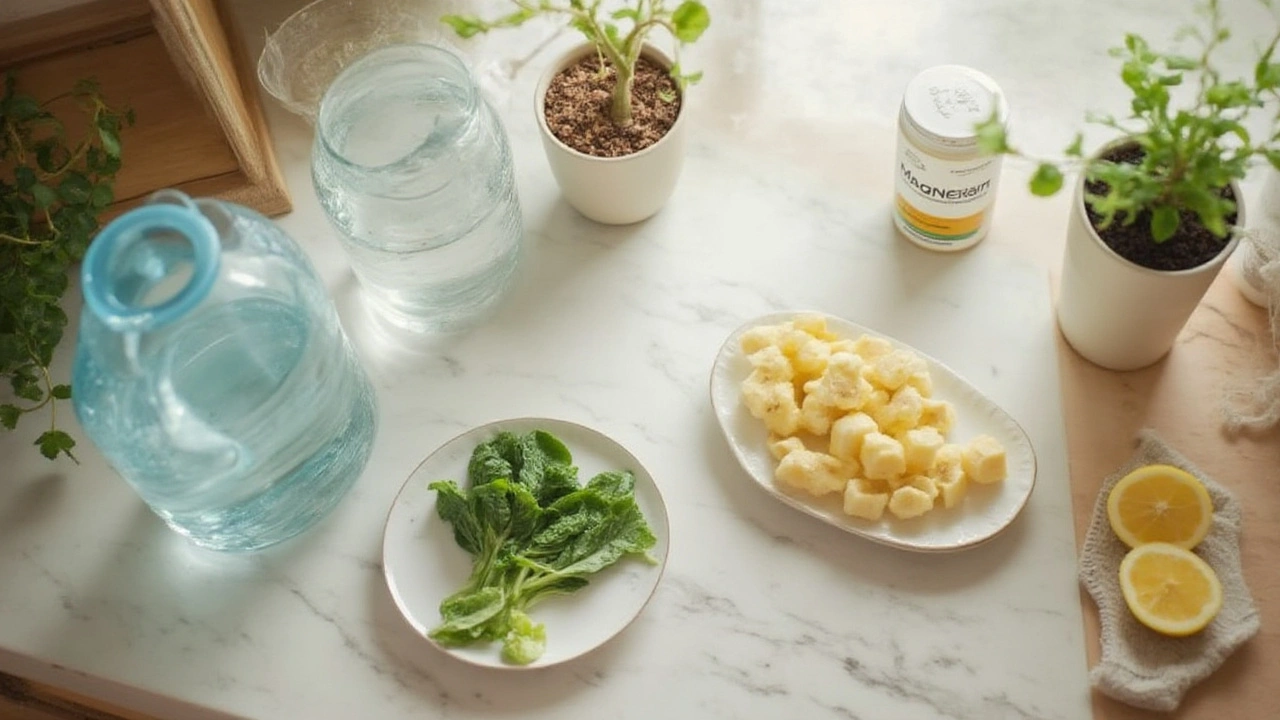Beat Pizza Bloat: Fast Fixes for Water Retention After Salty Food

That post-pizza puffiness can feel like a cruel joke. You wake up, look in the mirror, and your cheeks are more chipmunk than person. Tight rings, sock marks, swollen fingers—it’s all down to water hanging on for dear life after a salty slice (or four). But here’s the kicker: this bloat isn’t random. Do you know what’s really happening to your body, and how you can make it chill out—fast?
Why Does Pizza Make You Puffy?
The cheese, cured meats, and that golden, salty crust are the perfect storm for water retention. Sodium—basically, plain old salt—pulls fluid into your tissues. One takeaway pizza can have 2,000mg of sodium or more. That’s almost your full daily recommended intake in just a single meal. Spot the science: when you eat salt, your kidneys slow down on getting rid of water to keep the balance in your bloodstream. Cells soak up that extra fluid like sponges to dilute the sodium, showing up as puffy eyes or that tight, uncomfortable feeling in your skin or hands.
But it’s not just a pizza-night problem. Supermarket soups, ready meals, even salad dressings can be salt bombs hiding in plain sight. Your body reacts the same way every time you overload on sodium. The result? That annoying "hangover" that takes hours—or days—to fade.
To check if your salt-loving habits are sabotaging you, you can actually track it. Grab a food label: if it says more than 1.5g of salt (about 600mg sodium) per 100g, it’s heading into high territory. Even healthy-sounding pies, wraps, and ‘fitness’ snacks can sneak up on you. And the numbers don’t lie—about 75% of the sodium most people eat comes from processed foods, not the saltshaker.
Hydration Hacks: How Water Works Against Salt Bloat
It sounds backwards, but when you’re bloated from salt, drinking more water is the fastest way out. More water helps flush out the extra sodium, signaling your kidneys to get moving again. Think of your bloodstream like a river—add more water to dilute flood zones caused by a salt spike, and things flow smoothly again.
Start with a big glass of water as soon as you notice the puffiness, then keep sipping all day. Don’t chug liters at once; your body works best when you space it out. Keeping a bottle within arm’s reach makes it easy. Every time you feel that dry mouth, go for it. If you want to get nerdy, aim for about 2 liters (about 8 cups) over the day, but your needs change with the weather and your activity.
Pro tip: add lemon to your water—not because it magically "detoxes," but the flavor encourages you to drink more. Sparkling water counts too (just skip the super salty types like some mineral waters with extra sodium). And if you’re worried about plain water getting boring, try herbal teas with no sugar.
But don’t forget, caffeine and alcohol fight against you. Both are diuretics, so even though they make you pee more, they can actually leave you more dehydrated, stressing out your kidneys just when you need them to help. So if you’re on a post-pizza mission, stick to water.

Eat Your Way Back to Balance: Power Up With Potassium and Magnesium
If sodium is the villain, potassium and magnesium are the heroes. These minerals are your body’s natural water regulators. They tell your kidneys when to hold water and when to let it go. Potassium, in particular, helps counteract the effects of too much sodium and encourages your body to release the water you’re holding onto.
Best food sources? Bananas are famous for potassium, but sweet potatoes, avocados, and spinach are even better. Tossing a handful of spinach into your morning smoothie or snacking on some melon can pack a real punch. For magnesium, nuts—like almonds and cashews—are your friends, along with beans and whole grains.
Try making a "post-pizza" plate: steamed broccoli, sliced avocado, a handful of roasted chickpeas, and some watermelon on the side. This combo will load you up on the right minerals and fiber to help your system bounce back faster. Canned beans are an easy win, too—rinse them off to lower any extra salt.
What about quick fixes like supplements? They can help, but getting these minerals naturally from foods means your body absorbs them more easily and gets extra nutrients. Unless you’re vegan or on a restrictive diet, you probably don’t need an emergency potassium pill. But if you’re feeling desperate, a magnesium supplement before bed may help muscle relaxation and sleep, which sometimes gets thrown off by too much sodium.
Get Moving: Why Light Exercise Speeds Up Bloat Relief
Lying on the couch right after a pizza binge sounds tempting, but moving around can actually get that puffy feeling to fade faster. Gentle exercise—think brisk walking, stretching, or an easy bike ride—kickstarts your circulation and helps your body shuttle fluid to where it needs to go (and out via your bladder).
There’s no need to hit the gym hard. In fact, intense workouts when you’re feeling bloated can backfire because you sweat out water and electrolytes, which might leave you more thirsty or even more swollen if you don’t hydrate properly. Instead, opt for something easy: ten minutes walking after dinner, going up and down your stairs, or a few yoga poses. The key is movement, not exhaustion.
Your lymphatic system, which is like a secondary circulation network behind your veins and arteries, only gets a proper workout when you move. That’s how the leftover fluid, stacked up in your hands and ankles, finally makes its exit. Try these easy mini-moves:
- Shoulder shrugs and neck rolls if your face feels tight
- Ankle circles or tiptoe walks for sock-mark ankles
- Wrist stretches and finger wiggles for swollen hands
If you’re stuck at your desk, even changing positions every half hour will help. A bit of activity trumps sitting still every time.
Ever wondered if sweating it out in a sauna or steam room helps? It does speed up water loss, but this is mostly temporary fluid loss—not a cure for salt overload (and it may even dehydrate you more). Stick to regular movement and plenty of water for lasting results.

Smart Salt Swaps and Long-Term Strategies to Beat Bloating
No one wants to skip pizza forever—it’s comfort food for a reason. But if you’re tired of waking up with a rounder face and rings that don’t fit, making small tweaks to your favourite meals can help. Start with sauces and toppings: swap cured meats for grilled chicken or roasted veggies, and ditch extra cheese for herbs and a sprinkle of chili flakes. Try half the cheese on your pizza delivery next time—you’ll barely notice the difference in taste, but your face might stay slimmer.
Home-cooked versions let you control the salt. Make your own pizza base and use a light hand on the salt. If you’re eating out, check if restaurants show sodium counts online; many are required to by law in the UK and much of Europe now.
On your next grocery trip, compare products and pick lower-salt versions whenever possible. Canned beans, stocks, and breads all come in low-salt options. Keep an eye out for "salt" and "sodium"—sometimes they’re listed separately, but they mean the same bloat risk.
Keeping a food diary—even for a few days—can uncover where the hidden sodium is sneaking in. People often get surprised by how much comes from breakfast cereals or sauces. Apps like MyFitnessPal or Yazio can help you get a clearer idea, without the maths headache.
If you want to geek out even more, a quick read here on does salt make you puffy breaks down the details of why sodium makes you hang onto water in the first place, with tips backed by real research—not just urban legends.
There’s even tech to help these days. Smart scales with bioimpedance can give you an idea of water weight over time. While numbers can go up and down day by day, a sudden jump after a salty meal probably means water, not fat. Give it a couple of days, follow these steps, and it should resolve.
If you struggle constantly with swelling and not just after pizza, it’s worth talking to your GP. Persistent bloat can sometimes point to underlying health conditions like thyroid trouble, kidney issues, or side effects from certain medications.
| Food | Sodium (mg/100g) | Potassium (mg/100g) |
|---|---|---|
| Pepperoni pizza | 1,100 | 180 |
| Canned soup | 400-700 | 120 |
| Baked potato | 7 | 535 |
| Avocado | 7 | 485 |
| Banana | 1 | 358 |
| Spinach (cooked) | 70 | 540 |
One last tip: sleep is recovery time for your body. If you’re puffed up after a salty meal, try sleeping with your head slightly elevated. This can reduce facial swelling by morning. Wearing loose clothes, avoiding bracelets and tight shoes also helps your circulation do its thing.
No miracle fix will erase pizza puff in 10 minutes, but stacking strategies—hydration, minerals, gentle activity, and smart swaps—puts you back in control. Next time you see your face in the bathroom mirror, you’ll know exactly what to do.
Denise Wiley
July 24, 2025 AT 11:01Okay but why does pizza make me feel like I swallowed a balloon? I ate one slice last night and woke up looking like a chipmunk who raided a salt mine. This post literally saved my self-esteem.
Also, lemon water? Genius. I’ve been doing that and my face actually looks like it belongs to me again.
Brandon Trevino
July 25, 2025 AT 12:23Let’s be precise: sodium-induced fluid retention is a homeostatic response mediated by the renin-angiotensin-aldosterone system. The kidneys retain water to maintain osmotic equilibrium in response to elevated plasma sodium concentration. The notion that hydration ‘flushes’ sodium is a gross oversimplification. Diuresis occurs only after renal sodium excretion increases, which requires time and adequate glomerular filtration rate. Drinking water without electrolyte balance may exacerbate hyponatremia in susceptible individuals. Also, potassium’s role is overstated without addressing aldosterone dynamics.
Moreover, the table omits potassium-to-sodium ratios-critical for evaluating true physiological impact. A banana’s 358mg K+ is irrelevant if paired with 1100mg Na+ in pizza. You need molar ratios, not absolute values.
Austin Simko
July 26, 2025 AT 03:26Big Pharma owns the salt industry. They want you bloated so you buy more meds. The FDA knows this. They’ve been silent for 40 years. Water doesn’t fix it. Your kidneys are being poisoned.
Nicola Mari
July 27, 2025 AT 15:35I’ve seen people blame pizza for everything. This is the kind of pseudoscience that makes people believe in detox teas and ‘miracle’ minerals. The body regulates itself. If you’re bloated, you ate too much. Simple. No need for spreadsheets, lemon water, or ankle circles. Just stop eating junk. And if you can’t? Then maybe your problem isn’t sodium-it’s discipline.
Sam txf
July 28, 2025 AT 08:11Let me break this down like I’m talking to a toddler who thinks avocado is a vegetable: salt = water retention. Water = dilution. Potassium = sodium’s arch-nemesis. Movement = lymphatic drainage. No magic. No mysticism. Just biology. You want to stop looking like a puffin after pizza? Stop pretending you’re a nutritionist. Do the three things: drink water, eat spinach, walk. Done. No apps. No charts. No PhD required.
And if you’re still bloated? Maybe it’s not the pizza. Maybe it’s your ego.
Michael Segbawu
July 30, 2025 AT 05:03americans are so weak now they need a whole guide to stop being puffy after pizza i mean come on its just salt and cheese we used to eat this and go back to work no problem now everyone needs yoga and lemon water and potassium charts this is why the country is falling apart we used to be tough now we cry over a little swelling
Aarti Ray
July 30, 2025 AT 07:06i live in india and we eat so much salt in pickles and fried snacks and still no bloat like this
maybe its the processed cheese and bread here? i dont know but i think its not just salt its the whole package
also my grandma says drink warm water with cumin seeds in morning helps a lot
no lemon just cumin lol
Alexander Rolsen
July 31, 2025 AT 04:20...and yet, you still eat the pizza.
...and yet, you still drink the lemon water.
...and yet, you still scroll through this post while your face swells.
Here’s the truth: you don’t want to fix it. You want to feel justified in eating it. This entire article is a psychological Band-Aid. You’re addicted to the dopamine of processed food, and now you’ve weaponized biochemistry to soothe your guilt. You’re not bloated from sodium-you’re bloated from denial.
Go eat another slice. Then come back and tell me your lymphatic system is ‘stuck’ again.
Leah Doyle
July 31, 2025 AT 15:14This is so helpful!! I’ve been dealing with this for years and never knew why my fingers looked like sausages after pasta night 😅
I started doing the avocado-spinach-water thing and honestly? My rings fit again. I even made a little playlist of stretch moves for when I’m at my desk. Thank you for making this feel doable, not overwhelming!
Also-hot tip: I put my phone on the other side of the room so I have to get up to check it. It’s dumb, but I walk 10 extra times a day. Small wins!! 🙌
Alexis Mendoza
August 1, 2025 AT 22:14What if the real problem isn’t the pizza? What if it’s that we’ve forgotten how to be still? We eat fast. We move fast. We fix fast. But our bodies aren’t machines. They’re slow, patient systems. Maybe the bloating isn’t a glitch to fix-it’s a signal. A quiet voice saying: slow down. Eat with awareness. Sit with your food. Breathe.
Hydration, potassium, movement-they’re all good. But maybe the real cure is presence.
Just a thought.
Michelle N Allen
August 2, 2025 AT 05:37I read all this and then I just ate a whole pizza anyway. Honestly I don’t care if I look like a marshmallow tomorrow. I’m tired of feeling guilty about food. I like pizza. I like cheese. I like salty things. If my face swells, fine. I’ll wear sunglasses. I’ll say I’m just tired. I’ll pretend I’m a vampire who doesn’t like sunlight. I’m not changing my life for a few extra pounds of water. This post was long and I’m still not motivated. Let me be bloated in peace.
Madison Malone
August 3, 2025 AT 12:37You’re not alone. I used to feel so ashamed after pizza night. Like I failed at life. But then I realized-this isn’t about willpower. It’s about biology. Your body’s just doing its job. So I stopped fighting it. I eat pizza. I drink water. I walk around the block. I don’t punish myself. I just care for myself. And guess what? The puffiness fades. And so does the guilt.
You’re doing better than you think.
Graham Moyer-Stratton
August 5, 2025 AT 12:24Salt is the new sugar. The system wants you bloated so you buy more supplements. The FDA is complicit. Water is a placebo. Movement is distraction. The truth is buried under data.
tom charlton
August 6, 2025 AT 21:56Thank you for this comprehensive and evidence-based overview. The integration of physiological mechanisms with practical, actionable recommendations is exemplary. The inclusion of sodium-to-potassium ratios, the distinction between temporary fluid loss and true homeostatic correction, and the emphasis on behavioral sustainability rather than quick fixes represent a paradigm shift in nutritional education.
I would only add that individual variability in sodium sensitivity is highly dependent on genetic polymorphisms in the ENaC and ACE genes. Population-level guidelines may not reflect individual risk. A personalized approach, potentially involving genetic screening or ambulatory blood pressure monitoring, may be warranted for chronic sufferers.
Well done.
Jacob Hepworth-wain
August 7, 2025 AT 20:24Love this. I’ve been trying the avocado-spinach-chickpea plate after pizza and it’s a game-changer.
Also, I started doing those wrist stretches at my desk and my hands don’t feel like sausages anymore. Small changes. Big difference.
Thanks for making it feel less like a diet and more like self-care.